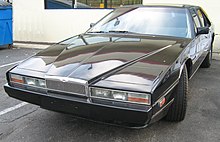Aston Martin Lagonda
- This article is about a particular model of motor vehicle. For the motor vehicle manufacturer, see Aston Martin Lagonda, Ltd.
| Aston Martin Lagonda | |
|---|---|
 1989 Aston Martin Lagonda Series 4 1989 Aston Martin Lagonda Series 4 | |
| Overview | |
| Manufacturer | Aston Martin |
| Production | 1976–1991 |
| Body and chassis | |
| Class | Grand tourer |
| Body style | 4-door saloon |
| Layout | FR layout |
| Powertrain | |
| Engine | 5.3 L V8 |
| Chronology | |
| Predecessor | Lagonda Rapide |
| Successor | Aston Martin Rapide |


The Aston Martin Lagonda was a luxury four-door saloon built by Aston Martin of Newport Pagnell, England, between 1976 and 1989. A total of 645 examples were produced at an average selling price of £150,000. The name was derived from the Lagonda marque that Aston Martin had purchased in 1947.
History
Aston Martin was facing severe financial pressure in the mid-1970s and needed something to bring in some much-needed funds. Traditionally, Aston Martin had worked on 2+2 sports cars, but the Lagonda was a four-door saloon with a brand new V8 engine. As soon as it was introduced, it drew in hundreds of deposits from potential customers, helping Aston Martin's cash reserves.
The car was designed by William Towns in an extreme interpretation of the classic 1970s "folded paper" style. It was as unconventional a design then as it is now. Car enthusiasts are fiercely divided on the car's aesthetic value.
Throughout the history of the marque, these hand-built Lagondas were amongst the most expensive saloons in the world. The only other "production" cars to approach its lofty price tag were the Rolls-Royce Silver Spirit/Silver Spur and Bentley Mulsanne.
The Lagonda was the first production car in the world to use computer management and a digital instrument panel, although the computers in many of the original cars are failure-prone. The development cost for the electronics alone on the Lagonda came to four times as much as the budget for the whole car. The second series used cathode ray tubes for the instrumentation, which proved even less reliable than the original model's LED display.
The Lagonda combined striking styling with opulent, club-like leather interior, and then-state-of-the-art instrumentation. Coupled to a Chrysler 3-speed "TorqueFlite" automatic transmission its 4-cam carbureted V8 provided poor, often single-digit miles-per-gallon.
A number of "series" were produced during the lifetime of the model, including a facelift in the 1980s.
Special variations of the series included:
Production
- Series 1 Aston Martin was a Lagonda V8 Saloon, a 4-door version of the V8, debuted in 1974; seven units were produced.
- Series 2 cars, produced from 1979 to 1985, were fitted with digital LED dashboards and touch pad controls.
- Series 3 cars, produced 1986 to 1987, featured fuel injected engines, had either the CRT or Vacuum Fluorescent dashes.
- Series 4 cars received an exterior facelift, the car's sharp edges rounded off and pop-up headlights eliminated. These models, produced from late 1987 to 1990, had Vacuum Fluorescent dash only.
Specifications
- Engine: 5.3 L (5340 cc/325 in³) DOHC V8
- Length: 17.4 ft (5.3 m)
- Width: 5 ft 11.5 in (1.816 m)
- Weight: 4,622 lb (2,097 kg)
- Top speed: 230 km/h (143 mph)
References
- ^ "Lagondawagon". Jalopnik.com. Retrieved 2009-09-11.
- Sujatha Menon, ed. (2004). Super Cars, Classics of Their Time. Quintet Publishing. ISBN 0-7607-6228-7.
{{cite book}}:|author=has generic name (help)
External links
- Lagonda Net — Roger Ivett's site dedicated to the Aston Martin Lagonda.
- Lagonda Rapier Enthusiasts web Site
- Official Used Aston Martin Locator
